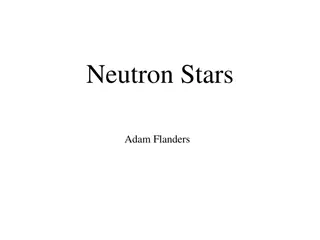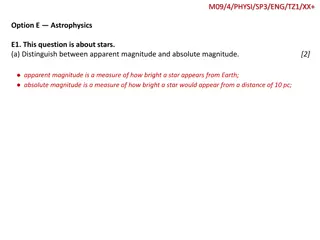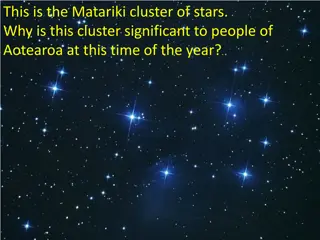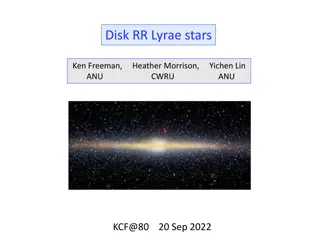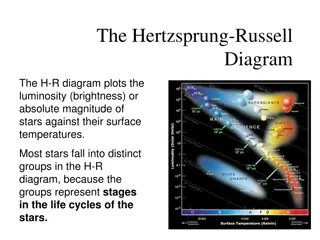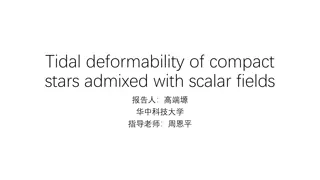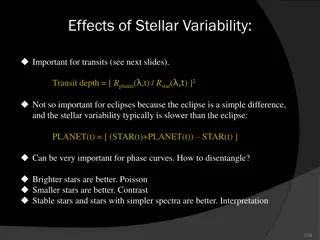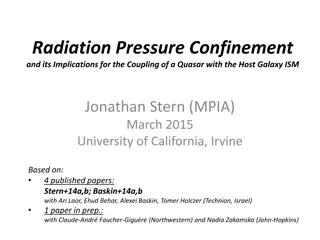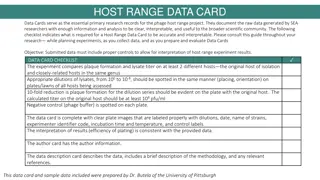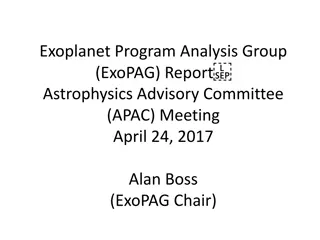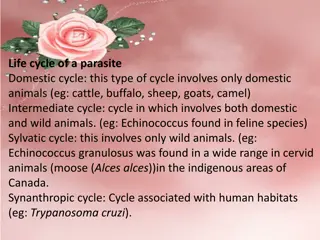Understanding Host Stars and Their Importance in Exoplanet Research
Host stars play a crucial role in determining the physical parameters of planets they host, impacting exoplanet characterization and planet formation understanding. Data from astrometry, photometry, and spectroscopy, combined with stellar evolutionary models, help derive host star properties critical for exoplanet studies. Knowledge of host star distance, proper motions, and nearby star census are essential for statistical analyses and identifying suitable targets. Host star properties carry information on planet formation mechanisms, highlighting the significance of studying these stellar bodies in astrophysics.
Download Presentation

Please find below an Image/Link to download the presentation.
The content on the website is provided AS IS for your information and personal use only. It may not be sold, licensed, or shared on other websites without obtaining consent from the author. Download presentation by click this link. If you encounter any issues during the download, it is possible that the publisher has removed the file from their server.
E N D
Presentation Transcript
PHY6795O Chapitres Choisis en Astrophysique Naines Brunes et Exoplan tes Chapter 8 Host stars
Contents 8.0 Introduction 8.1 Knowledge from astrometry 8.2 Photometry and spectroscopy 8.3 Evolutionary models 8.4 Element abundances 8.5 Asterosesimology 8.6 Activity and x-ray emission 8.7 Stellar multiplicity 8.8 Summary PHY6795O Naines brunes et Exoplan tes 8. Host stars 2
8.0 Introduction Host stars properties are fundamental for deriving the physical parameters of the planets they host RV technique relies on the knowledge of M for inferring MP. Transit technique relies on the knowledge of R for inferring RP. The atmospheric signal from a transit light curve scales as 1/R 2. Thus, exoplanet characterization strongly depends on the knowledge of the host stellar radius. Lensing technique relies on knowledge of the lens/source distance for inferring MP. The imaging technique relies on the age to convert (from models) the observed flux into a mass. Properties of host stars are derived from a combination of astrometric, photometric and spectroscopic observations interpreted within the context of stellar evolutionay models. Planets are known to exist around a wide variety of stellar types: main sequence stars, from late B to M, BDs, SDBs, giant stars and binary stars. Host star properties carry information on planet formation mechanisms (e.g. elemental abundance) PHY6795O Naines brunes et Exoplan tes 8. Host stars 3
Contents 8.0 Introduction 8.1 Knowledge from astrometry 8.2 Photometry and spectroscopy 8.3 Evolutionary models 8.4 Element abundances 8.5 Asterosesimology 8.6 Activity and x-ray emission 8.7 Stellar multiplicity 8.8 Summary PHY6795O Naines brunes et Exoplan tes 8. Host stars 4
8.1 Knowledge from astrometry (1) Distance and proper motions Distance is a key observable for deriving the host star properties. Majority of stars hosting planets are within 100 pc and have relatively good parallaxes from Hipparcos. PHY6795O Naines brunes et Exoplan tes 8. Host stars 5
8.1 Knowledge from astrometry (2) PHY6795O Naines brunes et Exoplan tes 8. Host stars 6
8.1 Knowledge from astrometry (3) Nearby star census Important for statistical studies and find suitable targets (e.g. of specific age). Difficult to establish complete census even out to modest distances of only 10-20 pc. Even though very numerous, low-mass stars are notoriously difficult to find since too faint. Catalogue of nearby stars Gliese/(Gliese-Jahreiss): GJ , out to 25 pc (1700 stars) Nstars Database, 2600 objects out to 25 pc. RECONS (Henry 2009); focus on finding missing (low-mass) stars within 10 pc. 376 stars within 10 pc as of 2012. LSPM (Lepine & Shara Proper Motion): 62 000 entries, 539 new candidate within 25 pc, 63 within 15 pc. PHY6795O Naines brunes et Exoplan tes 8. Host stars 7
8.1 Knowledge from astrometry (4) Nearby star census Important for statistical studies and find suitable targets (e.g. of specific age). Difficult to establish complete census even out to modest distances of only 10-20 pc. Even though very numerous, low-mass stars are notoriously difficult to find since too faint. Catalogue of nearby stars Gliese/(Gliese-Jahreiss): GJ , out to 25 pc (1700 stars) Nstars Database, 2600 objects out to 25 pc. RECONS (Henry 2009); focus on finding missing (low-mass) stars within 10 pc. 376 stars within 10 pc as of 2012. LSPM (Lepine & Shara Proper Motion): 62 000 entries, 539 new candidate within 25 pc, 63 within 15 pc. PHY6795O Naines brunes et Exoplan tes 8. Host stars 8
Contents 8.0 Introduction 8.1 Knowledge from astrometry 8.2 Photometry and spectroscopy 8.3 Evolutionary models 8.4 Element abundances 8.5 Asterosesimology 8.6 Activity and x-ray emission 8.7 Stellar multiplicity PHY6795O Naines brunes et Exoplan tes 8. Host stars 9
8.2 Photometry and spectroscopy (1) Bolometric magnitudes (Mbol) Total energy integrated over all wavelengths Distance modulus: Bolometric correction: (8.11) (8.12) F is the measured flux and S is the filter function. Bolometric luminosity (8.13) MV=4.83, Mbol =4.75 BC given for various filters (e.g. Pecaut & Mamajek 2012) PHY6795O Naines brunes et Exoplan tes 8. Host stars 10
8.2 Photometry and spectroscopy (2) Effective temperature (8.14) Determination of Teffrequires knowledge of both R and L . R determined through angular diameter (e.g. CHARA) combined with a distance and/or theoretical evolutionary models. L determined from Mbolwhich requires a distance. PHY6795O Naines brunes et Exoplan tes 8. Host stars 11
8.2 Photometry and spectroscopy (3) Parameters from spectroscopy Requires 2-3m telescopes and high-resolution chelle spectroscopy (R~50 70 000) covering most of the optical spectrum. At high (>100) S/N per resolution element. Relative line strengths and line profiles enable determination of the following four stellar parameters: effective temperature Teff, surface gravity log g, micro-turbulence velocity and metallicity [Fe/H]. Analysis make use of atmosphere, typically assuming plane parallel geometry (e.g. Kurucz 1993) and LTE conditions. Typical uncertainties on the parameters: 40-70 K for Teff, 0.02- 0.05 dex for [Fe/H] (8.15) This calibration is accurate within 47 K over the interval 4500 K < Teff< 6400, -0.85 < [Fe/H] < 0.40, and 0.51 < B-V < 1.20 PHY6795O Naines brunes et Exoplan tes 8. Host stars 12
8.2 Photometry and spectroscopy (4) Rotational velocity Line profile broadening yields an estimate v sin i Stellar rotation period P estimated from photometric variability induced by spots. If R is known, P yields v at the stellar equator, hence an estimate i through v sin i . Derived inclination is that of the stellar rotation axis which is not necessarily align with the orbital inclination. If assumed the same, then sin i estimate lift ambiguity on M sin i for planets detected through RV. Rotational velocity vs age (gyrochronology) Stellar rotation decreases with time due to angular momentum loss dictated by stellar winds whose intensity is a function of magnetic activity and rotation. Rotation rate converges at about 1 Gyr. PHY6795O Naines brunes et Exoplan tes 8. Host stars 13
Contents 8.0 Introduction 8.1 Knowledge from astrometry 8.2 Photometry and spectroscopy 8.3 Evolutionary models 8.4 Element abundances 8.5 Asterosesimology 8.6 Activity and x-ray emission 8.7 Stellar multiplicity 8.8 Summary PHY6795O Naines brunes et Exoplan tes 8. Host stars 14
8.3 Evolutionary models (1) Evolutionary models constitutes a key theoretical tool for constraining mass, radii and ages of host stars. Accurate stellar distances are essential in locating the position of a star in the HR diagram. Models depend on various parameters Chemical composition: X (H), Y (He), Z (metal) Detailed treatment of physical processes Line opacity Convection overshooting (cold sinking material penetrating beyond the tachocline, the transition between the radiative convective zones). Element diffusion Stellar rotation Evolutionary tracks Table giving mass, Teff, radi, log g vs time for a given initial mass. Isochrone HR diagram of an ensemble of stars at a given age PHY6795O Naines brunes et Exoplan tes 8. Host stars 15
8.3 Evolutionary models (2) Example of evolutionary tracks Padova models Bertelli et al. (2008) PHY6795O Naines brunes et Exoplan tes 8. Host stars 16
8.3 Evolutionary models (3) Example of isochrones Padova models Bertelli et al. (2008) PHY6795O Naines brunes et Exoplan tes 8. Host stars 17
8.3 Evolutionary models (4) Example of an isochrone table Bressan et al. (2012) PHY6795O Naines brunes et Exoplan tes 8. Host stars 18
8.3 Evolutionary models (5) Evolution of stars, brown dwarfs and giant planets Burrows et al. (1997) PHY6795O Naines brunes et Exoplan tes 8. Host stars 19
8.3 Evolutionary models (6) (Incomplete) list of evolutionary models Low and massive stars Siess, Dufour & Forestini (2000) http://www.astro.ulb.ac.be/~siess/pmwiki/pmwiki.php/Site/WWWTools Padova (PARSEC models; Bressan et al. 2012) http://stev.oapd.inaf.it/cgi-bin/cmd Yontsei-Yale (Demarque et al. 2001) http://www.astro.yale.edu/demarque/yyiso.html Darmouth (Dotter et al. 2008; recent models includes magnetic field) http://stellar.dartmouth.edu/models/index.html Geneva models (massive stars, rotation; Ekstrom et al. 2012) http://obswww.unige.ch/Recherche/evol/-Database- Low-mass, brown dwarfs and planets Lyon models (COND, DUSTY; Baraffe et al. 2003) http://perso.ens-lyon.fr/isabelle.baraffe/ Burrows et al. (1997,1998), Saumon & Marley (2008) PHY6795O Naines brunes et Exoplan tes 8. Host stars 20
8.3 Evolutionary models (7) (Commonly used) atmosphere models Low and (mostly) massive stars Castelli & Kurucz (2004) Wavelength range: 0.1 10 microns Teff range: 3000 50 000 K Low-mass stars, brown dwarfs and giants planets Pheonix/NextGen group (Hauschildt et al. 1999; Allard et al. 2012) 400 < Teff < 70 000 K; -0.5 < log (g) < 5.5; -4.0 <[M/H] < 0.5 Most recent models: BT-Settl, include treatment of clouds. Morley et al. (2012) L & T dwarfs with clouds PHY6795O Naines brunes et Exoplan tes 8. Host stars 21
8.3 Evolutionary models (8) Age properties of planet host stars Age determined through: Isochrone fitting Lower limits inferred from Li abundance bs Teff based on calibrations using open clusters of different ages (Sestito & Randich 2005) Ca II activity age relation (Wright et al. 2004) Uncertainties are significant Age distribution (Saffe et al. 2005) very similar to that of solar neighborhood stars. From Ca II: 5.2 4 Gyr; from isochrones: 7.4 4 Gyr Velocity dispersion of planet host stars is lower compared to disk stars suggesting that their average age is ~60% that of representative subset of the disk (Reid 2002). Age distribution of nearby FGK stars consistent with a uniform star formation rate over the 10 Gyr history of the Galactic disk. Most planet host stars are in contrast younger than 5 Gyr. PHY6795O Naines brunes et Exoplan tes 8. Host stars 22
8.3 Evolutionary models (9) Li abundance vs age Sestito & Randich (2005) PHY6795O Naines brunes et Exoplan tes 8. Host stars 23
8.3 Evolutionary models (10) Ca II activity (R HKindex) vs age Chromospheric emission from Ca II is correlated to the stellar rotation period which itself is related to age. Wright et al. (2004) PHY6795O Naines brunes et Exoplan tes 8. Host stars 24
Contents 8.0 Introduction 8.1 Knowledge from astrometry 8.2 Photometry and spectroscopy 8.3 Evolutionary models 8.4 Element abundances 8.5 Asterosesimology 8.6 Activity and x-ray emission 8.7 Stellar multiplicity 8.8 Summary PHY6795O Naines brunes et Exoplan tes 8. Host stars 25
8.4 Elemental abundances (1) Definition of metallicity Thus [Fe/H] is the abundance of Fe relative to the Sun. The fraction of metals referred to all elements more massive than He. Metallicity and Teff not easily measured. Establishing statistical differences between stars w/o planets [Fe/H] accuracy at the level of 0.1-0.2 dex. Nearby solar-type stars have [Fe/H]~0 while planet host stars have [Fe/H]~0.15 Planet occurrence appears to be a strong function of [Fe/H]. Extensive literature for abundance analysis. PHY6795O Naines brunes et Exoplan tes 8. Host stars 26
8.4 Elemental abundances (2) Compilation of [Fe/H] investigations PHY6795O Naines brunes et Exoplan tes 8. Host stars 27
8.4 Elemental abundances (3) Planet occurrence vs metallicity (8.16) PHY6795O Naines brunes et Exoplan tes 8. Host stars 28
8.4 Elemental abundances (4) Planet occurrence vs metallicity Correlation between planet occurrence and [Fe/H] extends as well to close-in transiting systems. High [Fe/H] explains anomously large radii measured for some systems (e.g. HD209458b) Radiogenic elements are an internal energy source (~0.5% of the incoming luminosity) that acts to slow down the cooling of the planet. To reconcile observed and theoretical radii, ~20 ME is required to explain the [Fe/H]~0 of solar type stars. Up to ~100 ME to explain stars with [Fe/H] three times solar. These results add to the big picture that heavy elements play a key role in the formation of close-in giants. Planet occurrence correlation with [Fe/H] not observed in giants stars. PHY6795O Naines brunes et Exoplan tes 8. Host stars 29
8.4 Elemental abundances (5) PHY6795O Naines brunes et Exoplan tes 8. Host stars 30
8.4 Elemental abundances (6) M dwarfs Spectra of M dwarfs are complex due to the presence of several molecules. Difficult to determine [Fe/H] through standard LTE spectroscopic modelling. [Fe/H] is best determined indirectly through photometric calibration (V- Ks) of more massive bound companions to M dwarfs. Results are inconclusive so far. Calibration of Bonfils et al (2005) suggest that M dwarf host of planets are metal poor (Bean et al. 2006) Calibration of Johnson & Apps (2009) suggests that mean [Fe/H] of M dwarf sample with planets is similar to FGK dwarfs with planet. Consistent pattern of [Fe/H] excess being correlated with planet occurrence. Planet occurrence around M dwarfs systematically lower compared to FGK dwarfs at any given [Fe/H], likely the result of their lower mass. M dwarf (M < 0.6 M ) planet occurrence: 3.4+2.2-0.9 % for Mp sin i > 0.3 MJ, a < 2.45 AU. Restricted to [Fe/H] > 0.2, occurrence rate rises to 10.7+5.9-4.2 % Neptune-mass planets do not form preferably around metal-rich stars. Results that rely on small number statistics. PHY6795O Naines brunes et Exoplan tes 8. Host stars 31
8.4 Elemental abundances (7) M dwarfs PHY6795O Naines brunes et Exoplan tes 8. Host stars 32
8.4 Elemental abundances (8) M dwarfs Spectra of M dwarfs are complex due to the presence of several molecules. Difficult to determine [Fe/H] through standard LTE spectroscopic modelling. [Fe/H] is best determined indirectly through photometric calibration (V- Ks) of more massive bound companions to M dwarfs. Results are inconclusive so far. Calibration of Bonfils et al (2005) suggest that M dwarf host of planets are metal poor (Bean et al. 2006) Calibration of Johnson & Apps (2009) suggests that mean [Fe/H] of M dwarf sample with planets is similar to FGK dwarfs with planet. Consistent pattern of [Fe/H] excess being correlated with planet occurrence. Planet occurrence around M dwarfs systematically lower compared to FGK dwarfs at any given [Fe/H], likely the result of their lower mass. M dwarf (M < 0.6 M ) planet occurrence: 3.4+2.2-0.9 % for Mp sin i > 0.3 MJ, a < 2.45 AU. Restricted to [Fe/H] > 0.2, occurrence rate rises to 10.7+5.9-4.2 % Neptune-mass planets do not form preferably around metal-rich stars. Results that rely on small number statistics. PHY6795O Naines brunes et Exoplan tes 8. Host stars 33
8.4 Elemental abundances (9) Origin of the metallicity difference two hypotheses Primordial scenario High [Fe/H] is a bulk property of the star and represents the original composition out of which the proto-planetary system formed Higher [Fe/H] means higher proportion of dust to gas in the protoplanetary disk. Facilitates condensation and accelerates accretion before the gas disk is lost. Giant planets subsequently formed by runaway accretion of gas onto a rocky cores of M~10 ME. Cut-off in [Fe/H] distribution for host stars > [Fe/H] > 0.5 represents the upper limit to metallicities in the solar neighborhood. Probability of forming a giant planet appears to proportional to the square the number of Fe atoms. Particule collision rate is also proportional to the square of the number of particules. This argues for a physical link between dust particule collisions in the promordial disk and the formation of giant planets. Detailed core accration models reproduce the distribution of giant planets with [Fe/H]. Also successfully predict that short period giant planets should be rare around M dwarfs but that Neptune mass ice-giants might be more common. PHY6795O Naines brunes et Exoplan tes 8. Host stars 34
8.4 Elemental abundances (10) Origin of the metallicity difference two hypotheses Self-enrichment of metallicity-enhanced material High [Fe/H] is a phenomenon restricted to the surface region of the star, arising from capture of metal-rich material, polluting the outer convective envelope. Might be the result of inward migration of a planet onto the star, slef- enrichment of gas-depleted, metal-rich material from the disk to the satr as a result of migration or breakup and infall of planets and planetesimals. A planet added to a fully convective star would lead to a negligeable [Fe/H] enhancement but perturbation is significant for solar-type sytars with relatively small convective zones comprising only a few % of the total mass. Plausible scenario Such pollution is directly observed in white Dwarfs. Differences between photospheric solar and meteoritic abundances could be explained if the Sun s convective envelope has been enriched by 0.07 dex compared to its interior. Prediction: there should be a correlation between planet host metallicity and the convection depth which is not observed, especially in subgiants. PHY6795O Naines brunes et Exoplan tes 8. Host stars 35
8.4 Elemental abundances (11) High-metallicity arising from pollution PHY6795O Naines brunes et Exoplan tes 8. Host stars 36
8.4 Elemental abundances (12) PHY6795O Naines brunes et Exoplan tes 8. Host stars 37
8.4 Elemental abundances (13) Origin of the metallicity difference two hypotheses Self-enrichment of metallicity-enhanced material High [Fe/H] is a phenomenon restricted to the surface region of the star, arising from capture of metal-rich material, polluting the outer convective envelope. Might be the result of inward migration of a planet onto the star, slef- enrichment of gas-depleted, metal-rich material from the disk to the satr as a result of migration or breakup and infall of planets and planetesimals. A planet added to a fully convective star would lead to a negligeable [Fe/H] enhancement but perturbation is significant for solar-type sytars with relatively small convective zones comprising only a few % of the total mass. Plausible scenario Such pollution is directly observed in white Dwarfs. Differences between photospheric solar and meteoritic abundances could be explained if the Sun s convective envelope has been enriched by 0.07 dex compared to its interior. Prediction: there should be a correlation between planet host metallicity and the convection depth which is not observed, especially in subgiants. General concensus is that the dominant effect is primordial. PHY6795O Naines brunes et Exoplan tes 8. Host stars 38
8.4 Elemental abundances (14) Another hypotheses - Different Galactic origin Giant planet occurrence-metallicity correlation is a dynamical manifestation related to the migration of stars in the Galactic disk Giant planet formation correlates with Galactocentric distance. Most metal-rich stars (Fe/H > +0.25 dex) found in the solar neighborhood (including those with planets) are considered to have migrated from the inner disk through radial mixing . Given Galactic metallicity gradient (0.07-0.1 dex/kpc), stars with mean [Fe/H] of +0.35 would originate at ~3-5 kpc from the Sun in the direction of the Galactic Center. Consistent with the origin of the Sun whose birthplace was inferred at a Galactocentric radius of 6.6 0.9 kpc based on its [Fe/H] larger by ~0.17 dex than the average of nearby stars os solar age. Hypothesis consistent with its space motion. PHY6795O Naines brunes et Exoplan tes 8. Host stars 39
8.4 Elemental abundances (15) Another hypotheses - Different Galactic origin PHY6795O Naines brunes et Exoplan tes 8. Host stars 40
8.4 Elemental abundances (16) Probability of forming a terrestrial planet PHY6795O Naines brunes et Exoplan tes 8. Host stars 41
8.4 Elemental abundances (17) Implication for terrestrial planet formation It is estimated that a [Fe/H at least half solar is required to build a habitable terrestrial planet. Concentrations of radiogenic isotopes 40K, 238U and 232Th will affect the efficiency of plate tectonics which may be an important recycling process providing feedback to stabilize temperatures. Relative abundance of Si and Mg affect the mass of the core relative to mantle. Since all elements and isotopes vary with time and location within the Galaxy as a result of star formation activity, planetary systems with the same metallicity as the Sun will not necessarily form Habitable Earth-like planets. In general, low-metallicity regions of the Galaxy (halo, thick disk and other thin disk) are not optimal for forming Earth-like planets. PHY6795O Naines brunes et Exoplan tes 8. Host stars 42
8.4 Elemental abundances (18) Li abundance Li provide an important (bu complex) diagnostic of both primordial nucleosynthesis and of (pre-) main sequence evolution. produced primarily through spallation (cosmic-ray reactions) with the interstellar gas. Both 6Li and 7Li are destroyed at T>2-3x106 K. This element can survive only in the outer 2-3% of the stellar mass. Li abundance reflects complex processes of mixing of matter, diffusion, and angular momentum evolution throughout the star s evolutionary history. The Li test uses the presence or absence of Li to distinguish candidate brown dwarfs from low-mass stars. High Li abundance combined with high chromospheric activity often indicates stellar youth. Planet hosts are observed to be depleted in Li suggesting that the presence of planets/disks increase the amount of mixing within its host. 7Li along with 2H, 3He and 4Hewere produced by the Big Bang. 6Li is PHY6795O Naines brunes et Exoplan tes 8. Host stars 43
8.4 Elemental abundances (19) Li abundance in planet hosts PHY6795O Naines brunes et Exoplan tes 8. Host stars 44
Contents 8.0 Introduction 8.1 Knowledge from astrometry 8.2 Photometry and spectroscopy 8.3 Evolutionary models 8.4 Element abundances 8.5 Asterosesimology 8.6 Activity and x-ray emission 8.7 Stellar multiplicity 8.8 Summary PHY6795O Naines brunes et Exoplan tes 8. Host stars 45
8.5 Asteroseismology (1) Asteroseismology, the study of oscillations, provides independant constraints on fundamental parameters such as mass, density, radius, age, rotation period and chemical composition. Done by comparing patterns of observed oscillations with predictions from theoretical predictions. Stellar osciallations are predicted over a wide range of mass and evolutionary states. Use of asteroseismic HR diagram. Information of high value since stars with the same externally observable parameters (L , Teff and [Fe/H]) cab have very different interiors as a result of their evolutionary histories. Asteroseismology is the best way of estimating the age of an individual star. Most observations are done by photometry, best achieved in space (e.g. COROT, MOST, Kepler, ), but also through radial velocity. PHY6795O Naines brunes et Exoplan tes 8. Host stars 46
8.5 Asteroseismology (2) Applications PHY6795O Naines brunes et Exoplan tes 8. Host stars 47
8.5 Asteroseismology (3) Applications PHY6795O Naines brunes et Exoplan tes 8. Host stars 48
Contents 8.0 Introduction 8.1 Knowledge from astrometry 8.2 Photometry and spectroscopy 8.3 Evolutionary models 8.4 Element abundances 8.5 Asterosesimology 8.6 Activity and x-ray emission 8.7 Stellar multiplicity 8.8 Summary PHY6795O Naines brunes et Exoplan tes 8. Host stars 49
8.6 Activity and X-ray emission (1) Magnetic and chromospheric activity This activity is usually inherent to the star but can also be enhanced/triggered through (magnetic) interaction with the star. Effects expected in outermost layers of the star (chromosphere, transition region, corona) The broad, deep atmospheric absorption lines of Ca II H and K provide an important diagnostic of chromospheric emission. Activity is usually modulated with the stellar rotation rate. PHY6795O Naines brunes et Exoplan tes 8. Host stars 50


